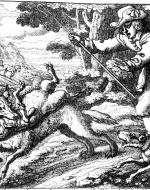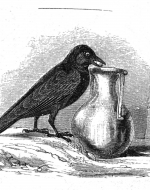Created by Posy Brown on Mon, 10/14/2024 - 18:12
Description:
Aesop (620-564 BCE) was a Greek storyteller and former slave who is still credited as one of the most legendary fabulists. Most of Aesop’s Fables feature animals, especially of African descent, such as elephants, camels, and apes. Aesop was rumored to be mute, which is an interesting layer to his legendary storytelling. According to myth, Aesop was a devout man, and his pious respect to the gods allowed him to regain his voice and be free from his muteness. Out of the 725 Aesop's Fables, Aesop is rumored to have written 400 of them. Aesop’s Fables teach moral lessons about honesty, greed, hard work, and modesty to children through the personification of animals and insects. Originally published by William Caxton in 1484, Aesop's Fables has attracted important illustrators over time, such as Francis Barlow, John Tenniel, and Ernest Griset. Moreover, Jean de la Fontaine (1621-95) based many of his popular fables on those of Aesop. Even though historians believe Aesop might not actually have existed or been a pseudonym created to share stories, his fables remain well known today through books and movie adaptations of his famous tales including "The Tortoise and the Hare."
Diego Velázquez, Esopo, 1638, Museo del Prado. Who was Aesop really? The man, the myth, the legend is no more than a myth himself. Aesop is known for his myths and fables, which is ironic because he himself is a man built out of myth and fable. There are many theories surrounding Aesop and who he was. Most historians believe he lived sometime around 570 BCE and died painfully at the hands of the people of Delphi. The reason for his death was either because he refused to supply them with money or because he stole a golden chalice. The most common myth is that he was a slave; however, historians argue over whether he was born into slavery or captured as a prisoner of war. The tale of Aesop’s freedom is the same in all legends; he was granted freedom because he impressed his master with his clever wit and intelligence. Another speculation about Aesop is that he was Ethiopian, and his heritage influenced many of fables and characters he created. Many of the myths surrounding him highlight his strong belief in pious morals and being rewarded for it, a direct correlation to the messages of rewarding piety in his own fables.
Francis Barlow, "The Boy Who Cried Wolf," Aesop’s Fables (ca. 600 BC), 1687 edition, Wikipedia. One of the most famous of Aesop's fables is “The Boy Who Cried Wolf.” Barlow's illustration of “The Boy Who Cried Wolf” features a shepard boy tasked with watching the sheep and making sure that a wolf does not eat them. He deems the work boring, so to entertain himself he calls for help from the villagers by yelling “wolf.” The villagers initially come running and find him laughing at how he has deceived them. He does this a second time to the same result. The third time, however, a wolf actually does appear, but when he calls for help no one comes as the villagers assume he is playing a prank on them again. The moral of the story is liars will not be believed even when they tell the truth. Barlow captures the moment when the wolf comes to attack the sheep, and no villagers come to his aid. The image depicts the boy with a frightened expression on his face as he chases the wolf,, who grips a sheep between his teeth. The depiction of the boy's fear and the viciousness of the wolf intensify the cautionary tale.
John Tenniel, “The Crow and the Pitcher,” Aesop’s Fables (ca. 600 bc), 1858 edition, John Murray. Another classic fable is “The Crow and the Pitcher.” “The Crow and the Pitcher" is a story about a crow who comes upon a pitcher filled with water, but the pitcher is too narrow for the crow’s beak to reach the water. After several failed attempts, the crow is about to give up when he gets the idea to use the pebbles scattered around and drop them into the pitcher until the water rises high enough for him to drink. The moral of the story is to never give up and always be resourceful! Tenniel chose to depict the crow in the action of putting a pebble into the pitcher. The scene is simple, but because of its simplicity Tenniel draws the viewer's attention to the crow and the pebbles that the crow is then able to use to reach his goal. The illustrations exemplify the moral teachings of Aesop's writing because of the way that the viewer is able to see the pebbles and draw their own solutions before even needing to read the fable. Tenniel is most well-known for his illustrations for Alice in Wonderland (1865) but was chosen by Carroll because of his skillful animal illustrations like that of the crow for Aesop's Fables. Aesop’s Fables and Alice in Wonderland have similarities through the use of animals to convey lessons, such as the Caterpillar in Alice and insects in many of Aesop’s Fables. Anticipating Alice, Tenniel's illustrations for Aesop’s Fables teach valuable lessons through animal stories while still being fun to read and entertaining for children.
Simonne Baudoin, "The Turtle and the Rabbit," from The Fables of La Fontaine, Translated by Marie Ponsot, Grosset and Dunlap, 1957, from the Personal Collection of Dr. Catherine Golden. Everyone has heard of "The Tortoise and the Hare," but what if I told you that there was also "The Turtle and the Rabbit"? "The Turtle and the Rabbit" follows basically the same plot as its predecessor with the turtle being slow and the rabbit being overconfident. Unlike the illustrations for Aesop's Fables, Baudoin draws the turtle and the rabbit wearing specifcally gendered clothing. The turtle is wearing a dress, which leads viewers to associate the turtle with femininity, while the rabbit is in a collared shirt and pants, which is typically correlated with masculinity. To further emphasis gender, Baudoin uses colors for the rabbit and turtles clothing. The rabbit wears blue, which is typicaly linked with men, while the turtle is wearing pink, which is linked to women. The use of clothing and color adds gender steryotypes to the fable, which weren't previously there. This illustration also brings to light the idea that women have to work twice as hard to be seen as "winners" in a patriachial society. The change in title also adds complexity as it relates to gender. The word "rabbit" is more commonly known in literature to be linked to femininity and fertility, which directly contrasts the gender displayed in the illustration. Take Peter Rabbit for example: the majority of the rabbits featured within that story are female (his sisters and his mother), and they display commonly feminine traits, such as kindess, obedience, and devotion. Rabbits in literature often take on feminine traits, while hares are more masculine, which is why Baudoin likely gives the rabbit masculine attire. Also, rabbits are born furless, blind, and helpless — vulnerable traits commonly associated with women. Hares, however, are much more akin to masculinity; they have a bigger build and are born with their eyes open and completely covered in hair. This illustrator, through the use of gendered clothing, gives a modern twist to a timeless tale.
Animaza Studios, “Aesop's Fables ‘The Tortoise and the Hare’ Short Film,” 2022, YouTube (https://www.youtube.com/watch?v=GfsGU4L7iT). Aesop's "The Tortoise and the Hare” features the moral of "slow and steady wins the race." A Tortoise and Hare are racing against each other. The Hare is cocky and overconfident in his ability to win, so he decides to take a nap believing that even with his nap, he will win with time to spare. However, while he sleeps, the Tortoise, who never stops, is able to pass and beat him! In 2022, the fable was turned into a short film, making it more digestible for younger audiences and more accessible for children with short attention spans. The film introduces a new way to look at moral lessons through a combonation of bright colors, animation, and narration. The fable's adaptability and continued relevancy speak to Aesop's importance even with the changing times and modernization of the world.






